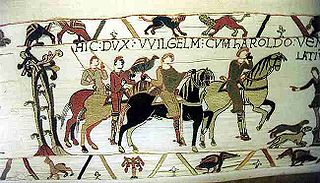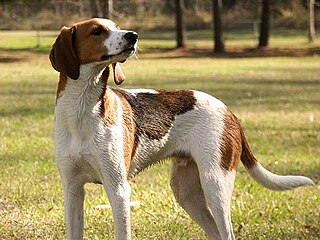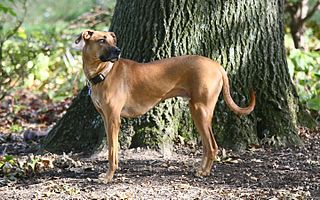
A hound is a type of hunting dog used by hunters to track or chase prey.

Scent hounds are a type of hound that primarily hunts by scent rather than sight. These breeds are hunting dogs and are generally regarded as having some of the most sensitive noses among dogs. Scent hounds specialize in following scent or smells. Most of them tend to have long, drooping ears and large nasal cavities to enhance smell sensitivity. They need to have relatively high endurance to be able to keep track of scent over long distances and rough terrain. It is believed that they were first bred by the Celts by crossbreeding mastiff-type dogs with sighthounds. The first established scent hounds were St. Hubert Hounds bred by monks in Belgium during the Middle Ages.

A coonhound, colloquially a coon dog, is a type of scenthound, a member of the hound group. They are an American type of hunting dog developed for the hunting of raccoons and also for feral pigs, bobcats, cougars, and bears. There are six distinct breeds of coonhound.

A hunting dog is a canine that hunts with or for hunters. There are several different types of hunting dog developed for various tasks and purposes. The major categories of hunting dog include hounds, terriers, dachshunds, cur type dogs, and gun dogs. Further distinctions within these categories can be made, based upon the dog's skills and capabilities. They are usually larger and have a more sensitive smell than normal dogs.
Hog-dog rodeo or hog-dogging, is a spectator event that simulates wild or feral boar hunting with dogs. It requires specially trained and bred "hog dogs" that are used to bay and sometimes catch a hog or boar. In most cases, bay dogs psychologically control the pig and no physical contact occurs. In some cases, however, such as Uncle Earl's Hog Dog Trials, along with bay dog events, catch dog events have been included in the past. In these, specially bred and equipped dogs caught and held the hog by the ears before the animals were quickly separated by a person who hog-tied the pig.

A feral pig is a domestic pig which has gone feral, meaning it lives in the wild. The term feral pig has also been applied to wild boars, which can interbreed with domestic pigs. They are found mostly in the Americas and Australia. Razorback and wild hog are Americanisms applied to feral pigs or boar–pig hybrids.

Royal hunting, also royal art of hunting, was a hunting practice of the aristocracy throughout the known world in the Middle Ages, from Europe to Far East. While humans hunted wild animals since time immemorial, and all classes engaged in hunting as an important source of food and at times the principal source of nutrition. The necessity of hunting was transformed into a stylized pastime of the aristocracy. More than a pastime, it was an important arena for social interaction, essential training for war, and a privilege and measurement of nobility. In Europe in the High Middle Ages the practice was widespread.

The Dogo Argentino is an Argentine breed of large dog of mastiff type. It was bred in the early twentieth century in Córdoba in central Argentina, primarily for hunting large game such as peccaries, wild boar and pumas. The foundation stock included the now extinct Córdoba fighting dog, a fighting dog of bulldog type, a Bull Terrier and a Mastín del Pirineo.

The Treeing Walker Coonhound is a breed of hound descended from the English and American Foxhounds. The breed originated in the United States when a stolen dog known as "Tennessee Lead" was crossed into the Walker Hound in the 19th century. The Treeing Walker Coonhound was recognized officially as a breed by the United Kennel Club in 1945 and by the American Kennel Club in 2012.

A feist is a small hunting dog, descended from the terriers brought over to the United States by British miners and other immigrants. These terriers probably included crosses between the Smooth Fox Terrier, the Manchester Terrier, and the now-extinct English White Terrier. These dogs were used as ratters, and gambling on their prowess in killing rats was a favorite hobby of their owners. Some of these dogs have been crossed with Greyhounds, Whippets or Italian Greyhounds, and Beagles or other hounds —extending the family to include a larger variety of purpose than the original ratter, or Rat Terrier.

The Black Mouth Cur, also known as the Southern Cur, Southern Black Mouth Cur and the Yellow Black Mouth Cur, is a medium to large sized breed of cur-type dog from the United States. Originating in the south of the country, the breed is a popular hunting companion used to hunt a large variety of game.
The Treeing Cur is a breed of dog that originated in the mid-west of the United States. It was first recognized by United Kennel Club on November 1, 1998, due to the efforts of Alex and Ray Kovac. "Most Cur breeders were not well off and so they required a dog that could serve multiple purposes: hunter, guardian, and stock dog. The result was the Treeing Cur, which is the most varied in size and colors of the Cur breeds", according to United Kennel Club. They are primarily used to tree squirrels, raccoons, opossum, wild boar, bears, mountain lion, bobcat as well as to hunt big game.

Dog types are broad categories of domestic dogs based on form, function, or style of work, lineage, or appearance. Some may be locally adapted dog types that may have the visual characteristics of a modern purebred dog. In contrast, modern dog breeds strictly adhere to long-established breed standards, that began with documented foundation breeding stock sharing a common set of inheritable characteristics, developed by long-established, reputable kennel clubs that recognize the dog as a purebred.

Boar–pig hybrid is a hybridized offspring of a cross between the Eurasian wild boar and any domestic pig. Feral hybrids exist throughout Eurasia, the Americas, Australia, and in other places where European settlers imported wild boars to use as game animals. In many areas, a variable mixture of these hybrids and feral pigs of all-domesticated original stock have become invasive species. Their status as pest animals has reached crisis proportions in Australia, parts of Brazil, and parts of the United States, and the animals are often freely hunted in hopes of eradicating them or at least reducing them to a controllable population.

The Sabueso Español or Spanish Hound is a scenthound breed with its origin in the far north of Iberian Peninsula. This breed has been used in this mountainous region since hundreds of years ago for all kind of game: wild boar, hare, brown bear, wolf, red deer, fox, roe deer and chamois. It is an exclusive working breed, employed in hunting with firearms.

A catch dog is a specially trained dog that is used to catch large animals in hunting, working livestock, and baiting.

A bay dog is a dog that is specially trained to find, chase, and then bay, or howl, at a safe distance from large animals during a hunt, such as during a wild boar hunt.

Wolf hunting with dogs is a method of wolf hunting which relies on the use of hunting dogs. While any dog, especially a hound used for hunting wolves may be loosely termed a "wolfhound", several dog breeds have been specifically bred for the purpose, some of which, such as the Irish Wolfhound, have the word in their breed name.

Coon hunting is the practice of hunting raccoons, most often for their meat and fur. It is almost always done with specially bred dogs called coonhounds, of which there are six breeds, and is most commonly associated with rural life in the Southern United States. Coon hunting is also popular in the rural Midwest. Most coon hunts take place at night, with the dogs being turned loose, trailing and putting the raccoon up a tree without human assistance. Once the raccoon is in the tree, with the dog at the base, it is referred to as "treed", with "treeing" being the active verb form.


























